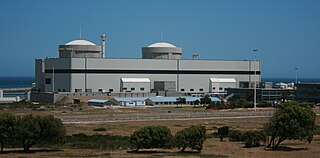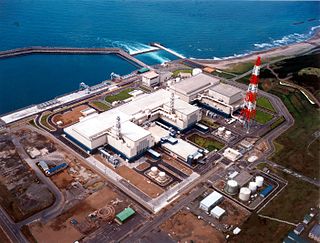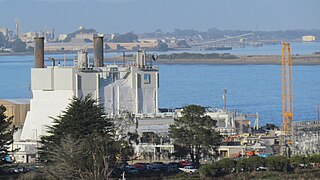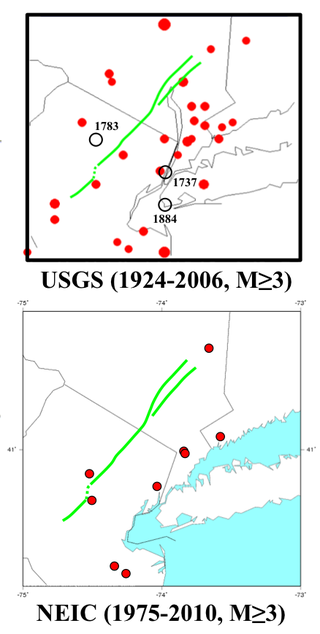Diablo Canyon (Nuclear) Power Plant, located in San Luis Obispo County California, was originally designed to withstand a 6.75 magnitude earthquake from four faults, including the nearby San Andreas Fault and Hosgri Fault, [1] but was later upgraded to withstand a 7.5 magnitude quake. [2] It has redundant seismic monitoring and a safety system designed to shut it down promptly in the event of significant ground motion.
In 2008 the Shoreline Fault, which passes less than a mile from the plant, was discovered. [3] The fault has the potential of triggering a 6.5-magnitude earthquake. [4] Because the Richter scale is logarithmic, Diablo Canyon is designed to withstand an earthquake of shaking amplitude ten times larger than that which the Shoreline fault is capable of triggering, based on an analysis by plant owner Pacific Gas & Electric (PG&E).
Diablo Canyon Power Plant (DCNPP/DCPP) is located proximal to the Los Osos, Hosgri, San Andreas and Shoreline faults. The discovery of these faults required design modifications during construction of the plant.
The Shoreline Fault is described in the November 2008 PG&E report as an "alignment of microseismicity subparallel to the coastline indicating the possible presence of a previously unidentified fault located about 1 km offshore of DCPP." [5] The plant's current operating license expires in 2030 and, in the aftermath of the Tohoku earthquake and tsunami, there is renewed opposition due to public perception that the risk of earthquake or tsunami might make the plant unsafe. Re-licensing is contingent upon consistency with the Coastal Act and thus review by the California Coastal Commission, however seismic issues are more properly within the purview of the Nuclear Regulatory Commission. The NRC in June 2011 announced that it had already completed its Safety Evaluation Report (SER) for the plant. [6] In July 2016 PG&E announced that it does not plan on relicensing either of its two Units.
Critics contend that the Diablo Canyon (Nuclear) Power Plant was built so close to a set of geological fault lines that it is "for all practical purposes" to be regarded as built "directly over" a fault. [7] [8] They refer to the Hosgri fault, which was discovered while the plant was under construction. No scientific corroboration for these opinions has been presented, and PG&E maintains that "new and extensive scientific re-evaluations performed at the direction of the Nuclear Regulatory Commission (NRC) continue to show that Diablo Canyon can safely withstand earthquakes, tsunamis and flooding that could potentially occur in the region." [9]
On July 15, 2011, PBS aired a 17-minute video documenting the controversy over the discovery of the Shoreline fault. [10] It details the differences of opinion between PG&E and a USGS geologist who disagrees with PG&E's assessment of the length of the Shoreline fault, and the potential for shaking should slippage occur at the Hosgri/Shoreline faults simultaneously.
The documentary also prominently features former California Assemblyman Sam Blakeslee, who after discovery of the Shoreline fault introduced legislation mandating 3-D seismic studies. Blakeslee, a former employee of Exxon-Mobil and an outspoken critic of the seismic evaluation undertaken in-house by PG&E, has come under fire by the California Democratic Party for alleged ties to California's fossil fuel industry. The Party alleges Blakeslee "led the effort to insert offshore drilling rights along the Santa Barbara coast as part of [2009] state budget negotiations", and he "used his Assembly position to rake in more than $56,000 from his friends in Big Oil including Exxon, BP, Chevron and Valero". [11]
According to the documentary, Blakeslee authored a bill in 2006 giving the California Energy Commission (CEC) "the power to assess the safety of [California's] nuclear plants", ostensibly to provide a seismic evaluation by an organization without involved financial interest. Others dispute CEC's impartiality. CEC Chairman Robert B. Weisenmiller co-founded and maintained a 24-year association with MRW & Associates, a company with areas of focus including "Fossil fuel generation", "Natural gas pipelines and storage", and "Liquified natural gas". On its website the company notes, "Because MRW maintains a singular focus on power and gas markets, we are ideally placed to help clients take advantage of the changes in market structure and industry regulation." [12] Nuclear energy has been perceived by many as a barrier to the expanding role of natural gas as a fuel for generating electricity, due to nuclear's lack of carbon emissions.
Three Pliocene-Miocene marine sedimentary units dominate the geology of Diablo Canyon: the Pismo Formation, the Monterey Formation, and the Obispo Formation. According to a Lawrence-Berkeley report entitled Geologic Investigation of a Potential Site for a Next-Generation Reactor Neutrino Oscillation Experiment – Diablo Canyon, San Luis Obispo County, CA [13] the area is tectonically active, located east of the active Hosgri Fault and in the southern limb of the northwest trending Pismo Syncline." The Obispo Formation is made up of marine and volcaniclastic sedimentary rocks. [13] [14] [15] [16] [17]
Various techniques are used to identify faults. These include: [18]
In 1989, the USGS of the Department of Interior published a report [19] titled "Empirical prediction of near-source ground motion for the Diablo Canyon power plant site, San Luis Obispo County, California". [20] Though the report was a primarily deterministic (empirical) analysis, it included a 1000-point Monte Carlo simulation to demonstrate that seven principal coefficients of ground motion were statistically significant at the 90-percent confidence level. More recent studies include a probabilistic [21] seismic hazard assessment. [18] As a result of studies by PG&E, it is determined that "ground motions from strike-slip earthquakes along the Hosgri fault zone have decreased and the ground motions from the reverse-slip earthquakes on the Los Osos and San Luis Bay fault zones have remained about the same". [5] [22]
The Shoreline Fault is a 25 km long vertical strike-slip fault, [3] identified in 2008, which lies approximately three hundred meters from the Diablo Canyon Nuclear Power Plant in California. According to Pacific Gas & Electric, the fault may produce quakes up to 6.5 magnitude. Mandated three-dimensional seismic studies have not been yet completed, and are not prerequisites for reissuance of the operating licenses for the two onsite units. [23]
According to USGS seismologist, Jeanne L. Hardebeck, the Shoreline Fault has potential to trigger an earthquake of 6.4–6.8 magnitude, [24] while the company asserts the facility is designed to withstand a 7.5 magnitude quake, [25] and NRC's estimate of the risk each year of an earthquake intense enough to cause core damage to the reactor at Diablo Canyon was 1 in 23,810 according to an NRC study published in August 2010. [26] [27]
The Office of Nuclear Reactor Regulation of the Nuclear Regulatory Commission provides oversight of Incident response teams and assures provision of an appropriate Incident commander for all adverse events including earthquakes. The company does have in place the following measures:
According to information provided by PG&E [28] the plant is designed to accommodate a ground acceleration of 0.75 g – three quarters of gravity. By comparison, the ground tremors experienced by the Fukushima Daiichi power plant was reported as 0.2–0.51g, with the plant certified to withstand 0.18–0.36g. Subsequent inspection showed no significant damage to any of Fukushima Daiichi's four reactors from the earthquake, [29] indicating all four reactors exceeded safety specifications by 0.02–0.15 g.
Diablo Canyon is designed to exceed a maximum oceanic flood level (combined tsunami, storm wave, high tide, and storm surge) of 32.0 feet above mean sea level (MSL) / 34.6 feet mean lower-low water (MLLW). The facility recently conducted a trial application of a Probabilistic Tsunami Hazard Assessment (PTHA) to evaluate lessons learned from the 2004 Sumatra tsunami as part of PG&E's Long-Term Seismic Plan (LTSP). This study shows that the hazard for tsunami waves of up to 3 meters (approximately 10 ft) is dominated by distant earthquakes around the circum-Pacific region, and is consistent with the historic record. The tsunami wave heights observed in San Luis Obispo County from the March 2011 Japanese tsunami were consistent with these results. [30]
Soil liquefaction resulting from earthquake activity has been raised as a concern[ citation needed ] however the plant and storage fuels are anchored on bedrock. [28]
In April 2011, in the wake of the Fukushima nuclear incident in Japan, PG&E asked the NRC not to issue license renewals until PG&E can complete new seismic studies, which are expected to take at least three years. [31] [32] The ongoing (as of 6/2011) seismic studies were recommended by the California Energy Commission and are approved and funded by the California Public Utilities Commission. [33]
On June 21, 2016, PG&E announced a Joint Proposal with labor and environmental organizations to increase investment in energy efficiency, renewables and storage, while phasing out nuclear power. Specifically, the operating licenses for Diablo Canyon Units 1 and 2 will not be renewed. These are set to expire on November 2, 2024, and August 26, 2025, respectively. [34]

The United States Nuclear Regulatory Commission (NRC) is an independent agency of the United States government tasked with protecting public health and safety related to nuclear energy. Established by the Energy Reorganization Act of 1974, the NRC began operations on January 19, 1975, as one of two successor agencies to the United States Atomic Energy Commission. Its functions include overseeing reactor safety and security, administering reactor licensing and renewal, licensing radioactive materials, radionuclide safety, and managing the storage, security, recycling, and disposal of spent fuel.

Koeberg Nuclear Power Station is a nuclear power station in South Africa and the only one on the African continent. It is located 30 km north of Cape Town, near Melkbosstrand on the west coast. It is owned and operated by the country's state-owned electricity public utility, Eskom.

The Diablo Canyon Power Plant is a nuclear power plant near Avila Beach in San Luis Obispo County, California. Following the permanent shutdown of the San Onofre Nuclear Generating Station in 2013, Diablo Canyon is now the only operational nuclear plant in California, as well as the state's largest single power station. It was the subject of controversy and protests during its construction, with nearly two thousand civil disobedience arrests in a two-week period in 1981.

The San Onofre Nuclear Generating Station (SONGS) is a permanently closed nuclear power plant located south of San Clemente, California, on the Pacific coast, in Nuclear Regulatory Commission Region IV. The plant was shut down in 2013 after defects were found in replacement steam generators; it is currently in the process of being decommissioned. The 2.2 GW of electricity supply lost when the plant shut down was replaced with 1.8 GW from new natural-gas-fired power plants and 250 MW from energy-storage projects.

The North Anna Nuclear Generating Station is a nuclear power plant on a 1,075-acre (435 ha) site in Louisa County, Virginia, in the Mid-Atlantic United States. The site is operated by Dominion Generation company and is jointly owned by the Dominion Virginia Power corporation (88.4%) and by the Old Dominion Electric Cooperative (11.6%).

The Watts Bar Nuclear Plant is a Tennessee Valley Authority (TVA) nuclear reactor pair used for electric power generation. It is located on a 1,770-acre (7.2 km²) site in Rhea County, Tennessee, near Spring City, between Chattanooga and Knoxville. Watts Bar supplies enough electricity for about 1.2 million households in the Tennessee Valley.
The Abalone Alliance (1977–1985) was a nonviolent civil disobedience group formed to shut down the Pacific Gas and Electric Company's Diablo Canyon Power Plant near San Luis Obispo on the central California coast in the United States. They modeled their affinity group-based organizational structure after the Clamshell Alliance which was then protesting the Seabrook Nuclear Power Plant in coastal New Hampshire. The group of activists took the name "Abalone Alliance" referring to the tens of thousands of wild California Red Abalone that were killed in 1974 in Diablo Cove when the unit's plumbing had its first hot flush.

The Tomari Nuclear Power Plant is the only nuclear power plant in Hokkaidō, Japan. It is located in the town of Tomari in the Furuu District and is managed by the Hokkaido Electric Power Company. All of the reactors are Mitsubishi designs. The plant site totals 1,350,000 m2, with an additional 70,000 m2 of reclaimed land.

The Tōkai Nuclear Power Plant was Japan's first commercial nuclear power plant. The first unit was built in the early 1960s to the British Magnox design, and generated power from 1966 until it was decommissioned in 1998. A second unit, built at the site in the 1970s, was the first in Japan to produce over 1000 MW of electricity. The site is located in Tokai in the Naka District in Ibaraki Prefecture, Japan and is operated by the Japan Atomic Power Company. The total site area amounts to 0.76 km2 with 0.33 km2, or 43% of it, being green area that the company is working to preserve.

The Kashiwazaki-Kariwa Nuclear Power Plant is a large, modern nuclear power plant on a 4.2-square-kilometer (1,000-acre) site. The campus spans the towns of Kashiwazaki and Kariwa in Niigata Prefecture, Japan, on the coast of the Sea of Japan, where it gets cooling water. The plant is owned and operated by Tokyo Electric Power Company (TEPCO), and it is the largest nuclear generating station in the world by net electrical power rating.
The 1970s proved to be a pivotal period for the anti-nuclear movement in California. Opposition to nuclear power in California coincided with the growth of the country's environmental movement. Opposition to nuclear power increased when President Richard Nixon called for the construction of 1000 nuclear plants by the year 2000.

The Humboldt Bay Power Plant, Unit 3 was a 63 MWe nuclear boiling water reactor, owned by Pacific Gas and Electric Company that operated from August 1963 to July 1976 just south of Eureka, California, in an area referred to as King Salmon and Fields Landing.
The Hosgri Fault is an offshore fault zone located near the Central Coast of California in San Luis Obispo County. The main fault stretches for about 87 miles (140 km), and is located nearest to the coastal communities of Cambria, San Simeon, Morro Bay, Baywood Park-Los Osos and Avila Beach. The fault system is some 260 mi (420 km) long, and is a right-lateral strand of the San Andreas Fault system.
Samuel Blakeslee is the founding Director of the Institute for Advanced Technology & Public Policy at California Polytechnic State University, San Luis Obispo. Blakeslee is a former Republican California State Senator representing California's 15th State Senate district which included the counties of Santa Clara, Monterey, San Luis Obispo, Santa Cruz and Santa Barbara. He previously served as a California State Assemblyman from California's 33rd State Assembly district, and a former State Assembly Republican Leader. He was elected to the California State Assembly in 2004 to represent the 33rd Assembly District, He was re-elected in 2006 and 2008, and elected to the California State Senate in 2010. Blakeslee retired from the Senate in December 2012.

Seismicity of the New York City area is relatively low. New York is less seismically active than California because it is far from any plate boundaries. Large and damaging intraplate earthquakes are relatively rare. When they do occur in the Northeastern United States, the areas affected by them are much larger than for earthquakes of similar magnitude on the West Coast of the United States. The largest known earthquake in the greater New York City area occurred in 1884, probably somewhere between Brooklyn and Sandy Hook, and had a magnitude of approximately 5. The New York quakes in 2023 and 2024 were shallow quakes.
Shoreline Fault is a 25 km long vertical strike-slip fault discovered in 2008 that lies less than a mile from the Diablo Canyon Nuclear Power Plant in California. It is thought to be able to produce quakes up to 6.8 magnitude. The San Luis Obispo County Board of Supervisors claims that it may potentially pose a threat to the nuclear plant despite the plant's operator, Pacific Gas and Electric, claiming that the facility is able to withstand a 7.5 magnitude quake.

On 11 March 2011, at 14:46 JST, a Mw 9.0–9.1 undersea megathrust earthquake occurred in the Pacific Ocean, 72 km (45 mi) east of the Oshika Peninsula of the Tōhoku region. It lasted approximately six minutes and caused a tsunami. It is sometimes known in Japan as the "Great East Japan Earthquake", among other names. The disaster is often referred to by its numerical date, 3.11.
San Luis Obispo Mothers for Peace (SLOMFP) is a participant in the anti-nuclear movement in California which is depicted in the anti-nuclear documentary film Dark Circle during the early years of protest opposing the Diablo Canyon Power Plant (DCPP). In Dark Circle, Mothers for Peace takes credit for delays which prevented the plant from going online prior to the discovery of the errors.
Alliance for Nuclear Responsibility is a non-profit, anti-nuclear, public interest organization founded in 2005, and based in San Luis Obispo, California. It is focused on public citizen activism and public participation with regard to the Diablo Canyon Power Plant, also known as the Diablo Canyon Nuclear Power Plant. The focus of the group is primarily on using leverage at the level of state agencies such as the California Public Utilities Commission. Concurrent jurisdiction of their concern also includes the California Coastal Commission, which certifies compliance of all action within the coastal zone which thus includes the plant. Their posture is primarily oppositional. Other venues for activism include the Nuclear Regulatory Commission, California Energy Commission, Regional Water Quality Control Board, SLO County, the California legislature, the office of the state attorney general, and the US Congress, of which they are in the 23rd District.